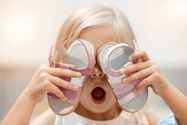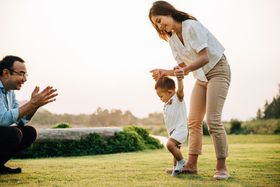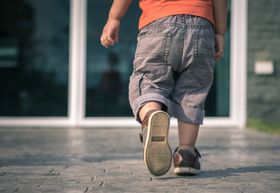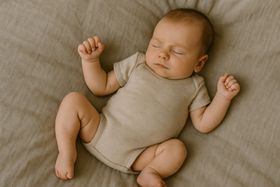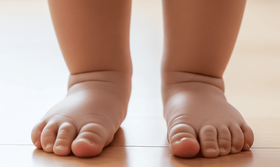Why Your Child Runs With Straight Legs: Addressing Gait Concerns
Is your child's running style causing concern? Learn the common reasons behind straight-leg running and when to seek professional advice
Published December 10, 2024
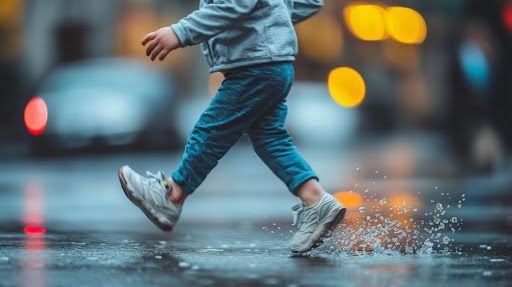
Children's movement is a fascinating journey of constant change and discovery. What might seem unusual or awkward to adult eyes is often just a natural stage of motor skill progression.
One such example is straight leg running, a common phase in young children's development. But is it normal? Is it healthy? Let's find out and how you can support your child through their development journey.
» Give your kid the support they need to run and play with ease
Understanding Gait Development in Children
Children's bodies constantly grow and change, and their movement patterns reflect this ongoing development. What might look unusual to an adult is often just a normal stage of motor skill progression.
The journey to independent walking begins around 12 to 18 months when children transition from cruising (holding onto furniture) to independent walking. These initial steps are characterised by:
- Wide-based stance for stability
- High arm positions for balance
- Flat-footed contact with the ground
- Short, uncertain steps
As kids mature, their walking mechanics evolve. They start heel-to-toe walking, increase their stride length, and improve their balance. By ages four to six, most children develop more advanced running mechanics with efficient knee bend and fluid movement.
» How fast do kids' feet actually grow? Find out here
What Does Straight-Legged Running Look Like?
Imagine a child moving across a playground, legs rigid and unbending, body bouncing with each step. This is straight-legged running—a movement pattern that looks uncomfortable and inefficient. Key characteristics include:
- Exaggerated vertical body movement
- Minimal knee flexion during stride
- Bouncy, hard-looking steps
- Limited stride transitions
- Faster onset of physical fatigue
While this might look alarming, it's often a normal phase of motor development.
» Explore the role of arch support shoes in children's foot health
Common Causes of Straight-Legged Running
Here are some key insights into why children might run with straight legs.
Muscular Development is a Gradual Process
Young children are still building muscle strength and coordination. This means they haven't learned to bend their knees efficiently during running, resulting in a more rigid, straight-legged motion. The body works with the muscle strength and motor control currently available to the child.
Further, during growth spurts, muscles might not keep pace with bone growth, causing temporary stiffness in calves or hamstrings.
» Keep them safe on every adventure with hiking boots for kids
Neurological Coordination Takes Time
Running requires complex neurological coordination between the brain and muscles. Young children are still developing these neural pathways, so their movements are more deliberate and less fluid than those of older children and adults.
Think of it as a computer learning to process new software—the connections are being built but are not yet smooth and automatic.
» Let your LO run free while giving them the support they need
Skeletal Structure Plays a Role
Children's bones and joints are more flexible and still forming. Their natural joint alignment and muscle attachments differ from adults, which can contribute to a straighter running style. Their body proportions and muscle mechanics will naturally adjust as they grow and become more refined.
» Encourage their adventures with the best walking shoes for kids
Potential Long-Term Implications
Untreated gait abnormalities can lead to several potential issues:
- Joint and Muscle Strain: Incorrect movement patterns create uneven pressure on joints and muscles
- Motor Skill Development Delays: Complex movements like jumping or balancing might become challenging
- Postural Problems: Persistent abnormal walking could affect the spine and overall body alignment
- Reduced Physical Confidence: Difficulty moving can impact a child's willingness to participate in physical activities
» Want to support your baby's development? Explore our supportive footwear collection
When to Observe and When to Worry
Not every unique movement pattern requires immediate medical intervention. However, parents should maintain awareness and know when professional guidance might be necessary.
Signs that suggest a potential need for professional evaluation include:
- Persistent Unusual Gait Beyond Expected Age Range: While straight-legged running is normal for toddlers, it might warrant further investigation if the pattern continues well into early childhood (around 5–6 years).
- Physical Discomfort or Limitation: If your child appears to be in pain while running, seems consistently uncoordinated, or struggles to keep up with peers during physical activities, these could indicate an underlying issue.
- Noticeable Asymmetry or Extreme Rigidity: While some variation is normal, if one leg consistently moves differently from the other or if the running style seems extremely rigid and unnatural, a medical consultation can help rule out any structural or neurological concerns.
» Discover what to look for in orthopaedic shoes for kids
Effective Interventions and Support
The good news is that many gait concerns can be addressed through proactive strategies:
- Physical Therapy: Specialized therapists can design targeted exercises to improve strength, flexibility, and coordination. They might use techniques like step-ups, balance drills, and specific stretching routines.
- Activity Modifications: Introducing low-impact activities like swimming or cycling can help develop smoother movement patterns. Structured play involving hopping and skipping can also encourage more dynamic leg mechanics.
- Orthotics: Custom orthotics can be inserted into supportive shoes for more complex gait issues to provide tailored support. These orthotics can address specific foot deformities or biomechanical imbalances.
- Supportive Shoes: Flexible, supportive shoes that allow natural foot movement can help reduce joint stress and promote better foot mechanics. Shoes with a wider toe box can allow for natural toe splay, while those with adequate cushioning can absorb shock and reduce impact forces.
Encouraging Healthy Movement
Remember that every child develops differently. Avoid comparing your child to others, and focus on creating a supportive environment that makes physical activity enjoyable. Regular, gentle encouragement and age-appropriate activities will help your child naturally improve their coordination and running mechanics.
First Walkers Orthopaedic Collection offers an excellent supplementary solution to support natural gait mechanics and movement patterns. Their thoughtful design can help kids develop confidence in their physical abilities, promoting smoother, more natural running and walking techniques.
» Invest in shoes that prioritise comfort so your kid can run worry-free
Disclaimer: First Walkers' information is intended for educational and informational purposes related to toddler footwear and feet. We encourage you to consider individual circumstances and consult qualified orthopaedists about specific conditions.
